Sir Henry "Tim" Birkin
Long distance racing driver & Bently Blower no.1
By Susan Hall
Henry Birkin was born in 1896 , the son of Sir Thomas Birkin 2nd Baronet and Hon. Diana Hopetoun Chetwynd, a well known family of Nottingham lace makers. He gained the nickname Tim in childhood, which stayed with him until he died.
He joined the Royal Flying Corp during World War I and gained the rank of Lieutenant in the service of the 108th (Norfolk and Suffolk Yeomanry) Field Brigade, serving in Palestine where he contracted Malaria, a disease from which he would suffer for the rest of his life.
In 1921 he took up motor racing but his family and business forced him into retirement. In 1927 he entered a three litre Bentley in a six hour race and in 1928 he aquired a four and a half litre Bentley and after some good results decided to return to racing. He became well known on the racing circuit and in June 1928 he entered the Le Mans race. He was leading for the first twenty laps but then a wheel jammed and forced him to drop back, but he completed the race, coming in fifth.
In July of that year Captain Birkins Bentley became the first British car to race in Germany after WWI, in the German Grand Prix.In August he entered the Ulster TT race and the George Boillot Cup in September, which was held in Boulogne.
The Bentley was a big car and Bentley themselves developed a bigger model called the speed six, this was huge and Bugatti reffered to it as “the world’s fastest lorry”.
In January 1929 Captain Birkin took one of the “new” factory units in Broadwater Road, Welwyn Garden City, for use in connection with research and experimantal work on motor car engines.
Birkin had come to the conclusion that the future of motor racing lay in having a car that was lighter than the speed six and fitted with some kind of supercharger. Bentley motors refused to create such a model so Birkin set about developing it himself.
With help form Clive Gallop on the technical side and Amherst Villiers, a supercharger specialist, Birkin rebuilt a four and a half litre Bentley at his engineering workshop in Welwyn Garden City. When his own money ran out the Hon. Dorothy Paget financed the project.
The first car produced was a stripped down Bently form Brooklands. By adding a hugh Roots-type supercharger (a blower) in front of the radiator, being driven straight from the crankshaft, it gave the car a unique appearance. The 242bph “blower Bentley” was born, the racer became known as Bentley Blower No.1. it was officially presented in 1929 at the British International Motor Show at Olympia, London.
In June 1929 Tim Birkin was back racing at Le Mans, with co driver Woolf Barnato. Captain Birkin intended to race the supercharged Bentley produced by the Broadwater Road factory but at the last minute Birkin decided that it was not giving complete satisfaction and with great disappointment did not race in it, but instead accepted an offer from Bentley to drive a speed six
The Le Mans course is ten miles around and is similar to road conditions in France. The drivers change after completing 20 laps, also at this point the cars are refuelled.
One of the conditions of the race is that the cars shall have standard equipment, they must carry ballast equivalent to carrying three passengers. From the very beginning of the race to the end of the trail they must not receive any outside help, in the case of a breakdown and in need of repair, they must only use the tools they carry in the car.
Birkin and co driver Woolf Barnato won the Le Mans 24 hour race with a record distance of 2,844.122 kilometre with an average speed of 118.5 kilometres an hour. Captain Birkin took the lead early on in the race and completed the second lap at a record average speed of 77.75 miles an hour. Birkin went on to break this record with an average speed lap of 80.62 miles an hour, with Woolf Barnato, his co driver beating that record. Not to be out done, Birkin came back with a lap record of 83 miles per hour, the fastest of the day. Birkin was driving at the end of the race and was carried shoulder high from the track.
The Bentley Blower no.1 first appeared at the Essex six hour race at Brooklands on 29 June 1929, however, the car initially proved to be very unreliable, W O Bentley himself never accepted the blower Bentley, but with Barnatos support, Birkin managed to persuade Bentley to produce the fifty supercharged cars that were necessary for the model to be accepted for the Le Mans twenty four hour race. In addition to these cars, Birkin put together a racing team of four remodelled “prototype”(three road cars for Le Mans and Blower no.1) and assembled a fifth car from spare parts.
On Saturday 13 July 1929 Captain Birkin entered the Irish International Grand Prix at Pheonix Park, Dublin. He drove a 4.5 litre supercharged Bentley, which was constructed and tuned at his workshop in Braodwater Road, Welwyn Garden City.
Captain Birkin completed the race, finishing third with an average speed of 79 mile per hour. At one point in the race he had to change a wheel, doing this in 45 seconds and then completed the record lap of the race at 83mph.
On 17 August 1929 Captain Birkin took part in the R.A.C. Touist Race in Belfast, although he was driving a 4.5 litre Bentley he only managed to come 11th.
On Easter Monday 21 April 1930 Henry Birkin broke the track record at Brooklands. The Welwyn Times called it “The greatest motor racing feat in history. Captain Birkin’s triumph with the car made at Welwyn Garden City”. He travelled a lap of two and three quarter miles at an average speed of 135.33 miles an hour, at one point reaching a speed of 150mph.
Captain Birkin was given a hearty send off by the citizens of Welwyn Garden City just before he headed off to France to take part in the Le Mans 24 hour endurance race. He did not win the Le Mans but he enabled his team to win, the daily papers called him a hero, “sacrificing himself and his car to ensure a British Victory”. Captain Birkin said they regarded themselves as a Welwyn Garden City team and although the actual winners were 6 cylinder Bentleys direct from the Bentley works, it was Birkin’s 4 cylinder car from his Braodwater Road works which secured the victory.
In July 1930 Bentley Motors withdrew from racing, this did not apply to Captain Birkin’s Bentleys as they were privately owned and under the control of Birkin and not the Bentley company. With the retirement of the Bentley firm, the British motor racing prestige rested with the Hon. Dorothy Paget, whose cars were managed by Captain Birkin.
In August 1930 Captain Birkin took part in a race at Brooklands, for which he was disqualified. There is a red line rule, that speedy cars must keep wide of this line, apparently Birkin passed on the wrong side of it and so was disqualified. He did manage to break the lap record and at one time was averaging 119mph.
The next race was the R.A.C. Tourist Trophy at the Ards circuit in Belfast. Captain Birkin drove the supercharged Bentley entered by Hon. Dorothy Paget.
On 21 August 1930 Captain Birkin was the only British driver to enter a big road race in Pau, France. He was driving a single seater Bentley in the Grand Prix de France over a three hundred mile course. Most of the other drivers were driving Buggati cars, the Bentley being entered by Hon. Dorothy Paget, the only British car in the race.
In a 500 mile race at Brookland in October 1930, Captain Birkin lapped at over 120mph. Two Bentleys were entered one being driven by Captain Birkin the other by Dr Benjafield. The team won the race with an aggregate time of 12 hours, 46 minutes and 12 seconds.
In November 1930 Hon. Dorothy Paget withdrew her finacial support for Birkins road team. The years racing had cost her £20,000 and she had been unlucky in not gaining a premier award. she did however, continue to support Birkins red single seater track car, nicknamed the Brooklands Battleship, the original Blower No.1. The car had been re-bodied with a single shell by Reid Railton after its lightweight fabric two seater body had caught fire in the 1929 500 mile race due to a cracked exhaust. Captain Birkin kept his workshop in Broadwater Road going by entering into partnership with Mike Couper and developed the business specialising in tuning high performance cars. He said he would never race with Bentleys again.
On the 8 April 1931 Henry Birkin’s father, Sir Thomas Stanley Birkin, Bart. died, leaving Henry to succeed the title of Sir Henry Birkin 3rd Baronet.
In the summer of 1931 Sir Henry Birkin again took the decision to race a four and a half litre Bentley owned by Hon. Dorothy Paget. The event took place at the Whitsun meeting at Brooklands where he would attempted to take the lap record to 139mph. Sir Henry came in third with his Bentley, and his other cars also did not perform at their best. He also failed in his attempt to break the lap record, only reaching 128.69mph.
In June 1931, partnered with co driver Earl Howe, Sir Henry won the 24 hour Le Mans endurance road race beating the previous record by 45 minutes. The drivers covered 1,970 miles with an average speed of 78mph.
On Saturday 8 August 1931 Sir Henry was involved in an accident, not involving racing cars. He was one of 18 passengers on the Imperial Airways giant liner, Hannibal, bound from Croydon to Paris, when it was forced to make an emergancy landing in a small field at Tudeley, Kent. The pilot, Captain F Dismore handled the aircraft, whilst Sir Henry pleaded with the passengers to stay calm and in their seats, and allow their bodies to go as limp as possible, one wing of the plane struck a telegraph pole and a tree stump caught in the wires of the tail unit, otherwise a safe landing and all the passengers lives were saved.
The national and local papers classed him as a hero.
His next race was the International Tourist Trophy race in Belfast, where he would be driving an Alfa. This race was to give Sir Henry the narrowest of escapes from death.
The 500,000 spectators around Belfast and the officials were not aware how badly damaged his car really was, they only believed that he had hit a sandbag and bent his brake gear.
He was going at great speed, passing competitors and averaging a speed of 80.48mph, after 13 laps he had every car beaton, some had even retired but racing driver Borzacchini had been told to go “all out”, Birkin tried to beat this and at Comber his car swerved six inches out of the chosen path and hit a sandbag barracade and Birkins jaw hit the seering wheel. He drove back to the replenishment pits and after careful scrutiny he restarted the race.
Unknown to him the damage on his car was vast, the car frame was broken, the front axel bent, the steering rods seriously strained and the steering wheel badly cracked. Every yard he drove he risked death, yet he completed 14 more laps before retiring, and two of those his average speed was 80.61mph.
The Alpha Romero was taken back to the workshops in Broadwater Road Welwyn Garden City and was repaired and put in fighting trim for the 500 mile race at Brooklands in October.
Sir Henry’s father, Sir Stanley, left no will so everything had to go through probate, (the letters of administration were granted on 11 december 1933 after Sir Henry’s death) and according to the documents sworn at probate, the estate was not a considerable sum. Sir Henry came into £250,00, which came from a trust from his grandfather, Sir T G Birkin, in September 1931.
At the October meeting at Brookland, Sir Henry was attempting to beat the track record set by Kaye Don and whilst travelling at 130mph, Birkins car burst into flames which enveloped the cockpit. Unable to reach the foot brake he stood on the drivers seat, he managed to switch off the engine and apply the hand brake, luckily he was not injured.
On Easter Monday 1932 Sir Henry Birkin was expected to enter a speed duel with Kaye Don at the Brooklands track, both were confident that they could lap at 140mph, 20mph faster than the maximum the track was designed for.
But, yet again Sir Henry narrowly escaped disaster. He won the 8th race of the day and managed to set a new track record of 138mph, driving the Hon. Dorothy Paget’s supercharged Bentley, but his race was fraught with problems.
The racers had to contend with 50mph winds, but Sir Henry still managed speeds in excess of 136mph. At one point in the race he was travelling at 145mph when the wind got underneath the car as it was leaving the railway embankment, and for three or four seconds the front wheels completely left the ground, when they touched the ground again, the car veered to the right and missed the railings by 6 inches. The gale got hold of the car again and sent it into a crab like action, on the last lap coming round the embankment near vickers, a fiercer gust of wind lifted the car inches off the concrete, the rear just missing the end posts of the fence.
In addition to the workshops in Broadwater Road tuning and experimenting with high performance cars they produced an “electic model of Brooklands”, in vented by Mr Kennedy of the Stock Exchange.
The idea was to give all the trills of a Brooklands race but indoors. The model cars were 6 inches long and were electrically driven along tracks of 18 feet and could amazingly reach speeds of up to 130mph. They were soley manufactured by Birkin and Couper under the name of Minature Speedway Ltd.
The cars were described as “exact replicas of a modern racing car and contain a small electric motor with a point of contact the rail over which it runs”. The rubber tyres would wear out after six hours. The track had intricate bends and it crossed in places going over and under itself giving a complicated course and a realistic effect with its trees and railings lining the side, even model mechanics and their tools lined the pits.
There was one track in the lecture room at Hatfield Aerodrome which was used privately. The idea was that six cars would race at once and each track ran the same distance. The cars were controlled by a push button, by manipulation of which, wide corners could be taken at full speed but great skill was needed on the narrower bends, which if taken too fast, the cars could come off the tracks. Each competitor had to complete 6 laps. Tracks were also being set up in the Haymarket and Brighton. It was advertised in the Daily Mail (see picture).
Sir Henry took part in the Guy’s Gala meeting,in July 1932, which was attended by the Duke and Duchess of York. He started from scratch in the Duke of York’s race and was passing the field at speeds of 120mph when the tread left his offside rear tyre and struck him on the right shoulder, making his arm temporarily unusable, but he managed to bring he car to a halt, he was later congratulated by the Duke.
On Monday 1 August 1932 Birkin took part in “the greatest racing thrill at Brookland”. Sir henry Birkin and J R Cobb drove two of the worlds fastest track racing cars ( Birkins Blower Bently and Cobbs Delage) over an eight and a half mile course being 3 laps. The result of which Sir Henry won the “Daily Herald” Trophy, for the second time, averaging 125.14mph and on his last lap reaching a speed of 137.30 in places, not quite beating his own record.
At the Tourist Trophy race in Belfast Birkin only managed to finish in fifth place, he was forced to retire for repair, which lost him valuable time, he finished with a time of 5 hours, 12 minutes and 45 seconds, the winner C R Whitcroft finished in 4 hours, 58 minutes and 4 seconds, although Birkin did manage the fastest average speed at 79mph.
On the 31 October 1932 the company Birkin and Couper Ltd was to be closed and a legal notice appeared in the Welwyn Times, there was to be a meeting of creditors to be held at 12.30pm on Wednesday 9 Novemeber at the institute of Chartered Accountants in London. On the 18 Novemeber 1932 another notice appears asking for any claims to be sent in by 27 December 1932, the company was going into liquidation.
By the end of 1932 Birkin had written a book called Full Throttle and was taken to court for lible. The Brooklands Estate Co. said it contained “remarks which were considred to be defamatory of them in connection with their running of the Brooklands race track”.
Sir Henry signed a document which was slipped into the book it stated ” My attention having been called to the fact that certain criticisms of the Brooklands track made in this book may be construde as a reflection upon the propriators of the track, and the Brookland Automobile Racing Club, in their conduct of the premises, I wish unreservedly to state that such was never my intention, I unreservedly withdraw such statements and tender my apologies for the publication of them”.
In March 1933 Birkins workshop was put up for auction by the liquidators. Dozens of cars lined up in Broadwater Road, when machinery, accessories and tools of Birkins and Couper’s workshop went under auction. Many garage proprietors and engineers were present and good prices were reached. Birkin originally aquired the workshops form the Garden City Company in 1929, at one time as many as 50 highly skilled engineers were employed at the workshops under Sir Henry Birkin, carrying out extensive experiments and research work. Sir Henry was a generous employer, and the men worked under model conditions.
When in partnership with Mr Couper, they use the workshops for tuning up expensive cars of the high powered mechanism, much of the work was done for Bentley.
During the last year, Miniature Speedway Ltd came into being. The workshops were then used to manufacture model racetracks.
On 7 May 1933 Sir Henry took part in the Tripoli Grand Prix driving a 3L Maserati 8C, in which he finished third, at one point he came in for refuellung, and whilst filling with oil, he leant across the car, burning both forearms on the hot exhaust pipe.
On 22 May 1933 he was visited by Dr Benjafield, a fellow racing driver and personal friend of Sir Henry. Sir Henry told him he had a temperature and thought he was suffering from Malaria, the wounds that he suffered earlier had almost healed.
By 1 June, Birkin was seriously ill and was in the Countess Carnavon Nursing Home, he gradually went down hill despite various treatments and died at 2.30pm on 22 June 1933. There was an inquest into his death, with the coroner returning a verdict of accidental death, he said “it seemed an irony of fate that a man who had taken his life in his hands so many times on the motor track, should have died in this way, from what was really a minor accident. I am sorry that a man of his ability and bravery should have met his death in this way”.
His funeral was held at Blakeney Church, Norfolk, on Monday 26th June 1933, where he was buried in the churchyard. Sir Malcolm Campbell, Earl Howe and Dr Benjafield were among those present.
Sir Henry Birkin was President of the Blakeney Royal Lifeboat Institution.
On 29 June 2012 a 1929 Bentley single-seat racer that once reached 137 miles per hour sold for £5,042,000. The 4.5-liter supercharged “Blower” Bentley was the star lot at Bonhams’s sale of the Daniels Collection of classic autos at the Goodwood Fesival of Speed, making it the most expensive British Built car ever sold at public auction
The car achieved record speeds around the banked Brooklands track when driven by Henry “Tim” Birkin, one of the “Bentley Boy” racers of the 1920s and 1930s.
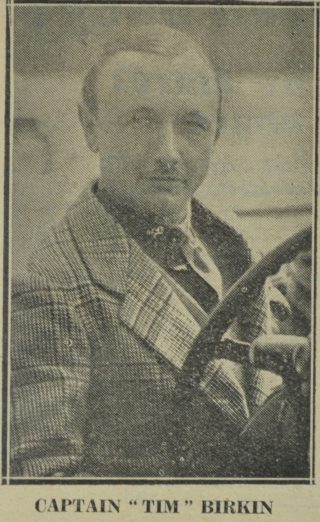
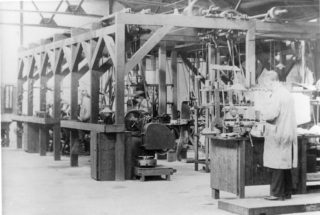
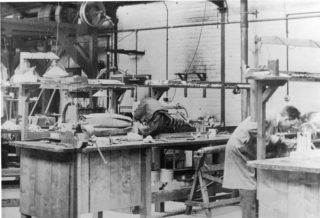
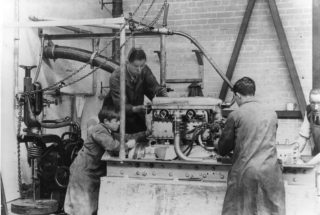
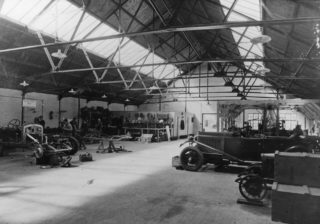
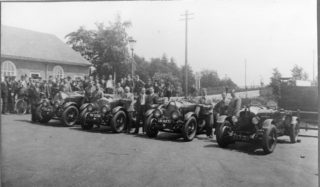
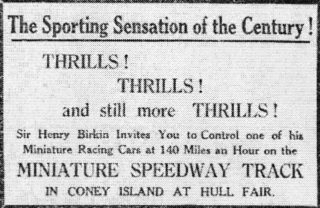
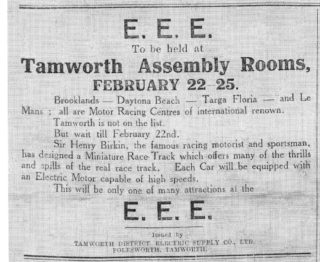
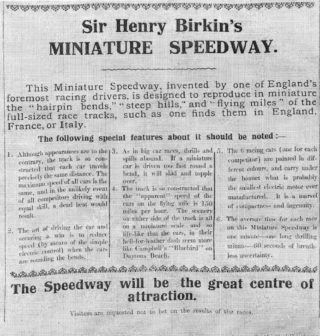






Add your comment about this page
Just saw this page. For those who asked about the Miniature Speedway, no track survived that we know of, but a number of the cars have emerged. Most of them are at Bernards Slot Car Museum in Houston, Texas, and a couple may still be in the UK or on the continent. Contrary to what seems to be implied, Birkin was an investor, not the inventor. The original concept was developed by P.G. Kennedy, and was first covered in a 1931 issue of The Autocar; there were several follow-up articles in 1932, with the first mention of Birkin.
My father Peter Rush worked on the Bentley (Birkin) race cars during the Dorothy Page era. Ironically he is also buried in Blakeney churchyard not far from Birkin.
Birkin was keen to participate in the WGC community. The Welwyn Times records him giving a tour of his motor works to local scouts, for example, and giving people rides round the Nabisco playing field in his Bentley on Town Day. After his win at Le Mans in 1929 Birkin displayed the car he’d driven to victory in Howardsgate. After the motor works closed blower Bentley No.1 was kept for a few years at the garage over the railway bridge on Stonehills. There is a great photo of mechanics there larking about with it.
After his partnership with Birkin fell apart Mike Couper established a car dealership in St. Albans that is still in business–W. M. Couper Ltd., trading now as Coupers.
At Le Mans in 1930 Birkin enabled the Bentley Motors team to win the race, not his own team–only two of the Birkin cars began the race and neither completed it. The Electric Model Brooklands tracks were made by a man hired for the purpose, not by the regular workshop staff. None of the tracks have survived.
I would very much like to know if any of the Brooklands Electric speedway models have survived.
Was this person involved in the Imperial Airways HP42 Hannibal force landed at Tatlingbury Farm, Tudeley on 8 August 1931?
Editor: Yes as described above.